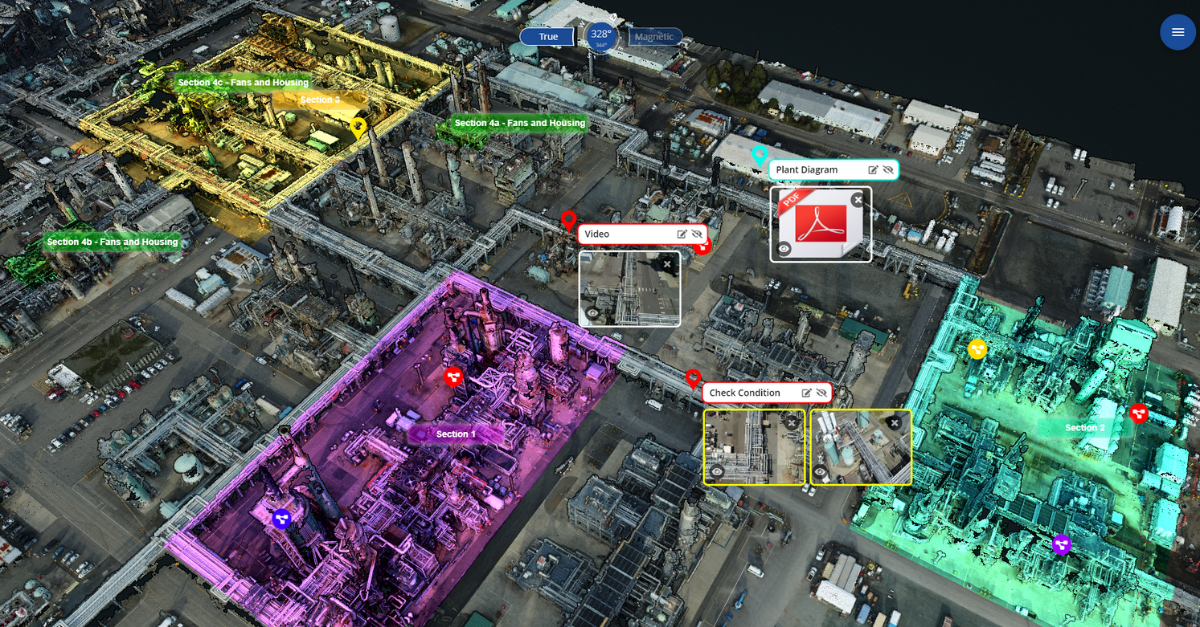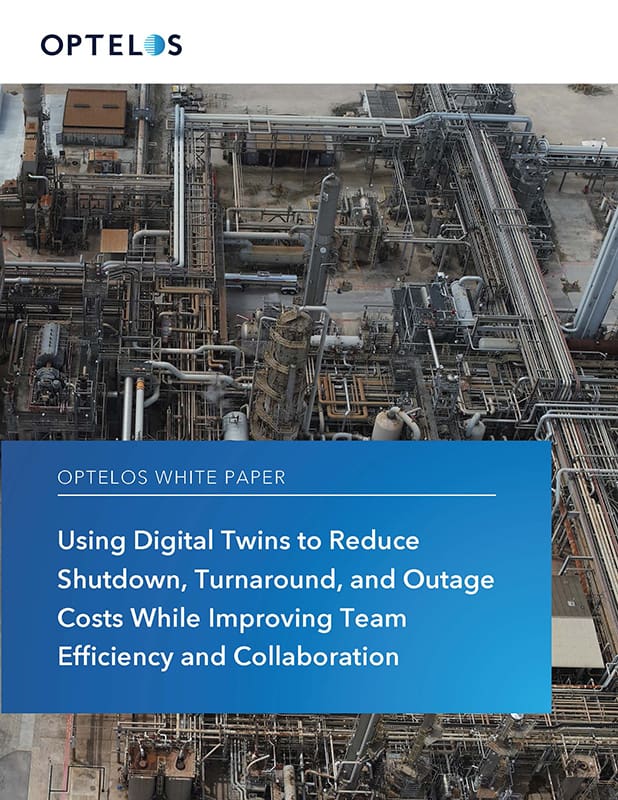Digital twins reduce STO costs when properly utilized in maintenance operations, offering new oversight and planning capabilities to TAR managers and supervisors.
Process unit shutdowns, turnarounds, and outages (STOs) are a core element of standard operations in asset-intensive industries such as oil and gas, chemical manufacturing, process manufacturing, and energy.
While STOs are expected and planned years out, they’re anything but routine and predictable. The overarching concern with the STO process is that it is costly, slow, and rife with unforeseen issues. They’re costly, complex, involve nearly every department in an enterprise, and require enormous coordination, detailed planning, and close coordination across multiple workgroups to pull off successfully.
Despite all the planning and resources dedicated to their success, most of the time objectives are not met. According to TA Cook and Solomon Associates:
- MORE THAN HALF of all STOs experience significant delays
- ALMOST 50% of work-related accidents in manufacturing plans occur during STOs
- 82% of all turnarounds do not satisfy all performance objectives
- 80% of all turnarounds are over budget by more than 10%
- 1 in 4 turnarounds significantly underperform and are deemed a failure
STOs require a significant amount of capital, labor, and resources. All of these must be managed with precision. And since there is only a short window to execute repairs, inspections, and initiate capital improvements, every stakeholder involved in the STO must coordinate project tasks efficiently to ensure a site is back online within the allotted time.
A small refinery, for example, can average around 1 million dollars per day in revenue; each day a site remains offline beyond its scheduled run date becomes lost production time. The consequence of mismanaging schedules, budgets, resources, or tasks can cause significant loss of revenue, an increase in operating and labor costs, and even impact the supply chain.
The good news is that many of the most common issues encountered during regular STO maintenance actions can be avoidable or significantly alleviated by integrating the use of digital twins into the maintenance process, improving team collaboration, information sharing, and decision certainty.
By utilizing digital twins as a core communication and documentation element, turnaround teams can dramatically improve communication and collaboration throughout their enterprise through the “single pane of glass” that digital twins offer, a unified and factual view of an asset with all relevant documentation housed together in one location.
Digital twins can become the single point of truth when organizations are seeking to understand an asset’s true current state, physical location, and juxtaposition to other equipment, and what other machinery, electrical, or piping is attached and needs to be included in the scope of work.
What We Will Cover:
- What are digital twins?
- Five phases of STOs and their challenges
- Use case example for digital twins while completing STOs
- Summary benefits
Digital Twins Definition
In the asset management industry, the term “digital twin” actually has multiple definitions, but we typically see two main types:
Performance Simulation Digital Twins
Performance metrics-based, used for:
- Predictive maintenance
- Asset performance and reliability
- Simulation and variable modeling
Visual Inspection Digital Twins
Visual reality-based, used for:
- Asset inspections
- Maintenance actions
- Measurements and analysis


Visual Inspection Digital Twins
When we refer to digital twins, we’re referring to the second type, the visual reality-based models that can be used for asset inspections. Visual Digital twins can be built utilizing various input devices such as unmanned aerial vehicles (UAVs, or more commonly “drones”), robot walkers, still cameras, and IoT sensors.
These highly detailed and accurate 3D point clouds and mesh models are typically utilized for assessing the current physical status of an object to use for completing an asset inspection.
When properly created and combined into a unified view, digital inspection twins provide immense value by eliminating information silos and helping facilitate collaboration across technical, operations, and management teams.
Shutdown, Turnaround and Outage (STO) Phases and Challenges
A shutdown, turnaround, and outage (STO) is a critical organizational activity because it always involves a key asset being taken offline or out of service and is only complete when this item is returned to service and performing at the desired level (“down” and “up” activities). STOs are uniquely complex, involving not only planned repair and upgrade activities but also emergent/unplanned work as a result of inspection of plant and processes not accessible or visible during normal operations.
Shutdown, turnaround, and outages are typically managed in five phases as described below:
- Scoping: Initial strategic planning for assets impacted, setting timeframes and budgeting, resource allocation, master site scheduling, and setting limits on what equipment is included.
- Preparation: Detailed project planning, budget allocation, logistics planning, field inspections, updating engineering data, creating work orders, and hiring subcontractors.
- Execution: Begins once the equipment is shut down. Execution of work orders, contractors, and workforce mobilization to perform the work that has been scoped. Concludes with final inspection to verify accuracy and completeness of work.
- Start-Up: After project work is complete, bringing the equipment back online and returning it to service. Testing and verifying safe equipment operation and performance within specifications.
- Review: Post-mortem analysis, lessons learned, vendor reviews, compare actual performance against targets and institutionalize lessons learned.
Unfortunately, many organizations face significant challenges in each of these phases due to data silos, lack of visual information about the plant assets, and reliance on disparate systems to manage these complex processes.
Common issues and challenges encountered during STOs include:
Scoping Challenges
Missing relevant data: Mistakes happen: assets are missed, machinery condition is misunderstood, or the work sequence is wrong and requires rework.
Limited Asset Information: Facilities may lack equipment operating parameters, operating performance, or limited equipment condition information. Often limited visual data on what the equipment looks like or its condition.
Preparation Challenges
Outdated Information: Outdated historical information, including outdated engineering data, plagues many turnaround maintenance actions.
Disjointed Data: Work orders for specialty crafts—welders, electricians, mechanics, pipe fitters—are often disjointed and spread out between maintenance, engineering, and contractors.
Execution Challenges
Poor Coordination: Efficient project management requires broad organizational coordination, such as Ops, Compliance, QA, and Area Coordinators. Otherwise, the punch list will grow sporadically.
Ad-Hoc Decision Making: Decision making suffers without access to trusted, verifiably accurate information. Without access to good information, project managers are often forced to make judgment calls which may be costly.
Start-Up Challenges
Unfamiliar Procedures:Many turnaround events involve equipment which is not routinely serviced, creating a risk as skilled, experienced technicians execute complex procedures on sophisticated and dangerous equipment.
Lack of Job Details: Missing or incomplete equipment technical data and procedures can be devastating during equipment return to service. Half of all OSHA-reportable injuries occur during start-ups.
Review Challenges
Incomplete Data & KPIs: Project KPI data may not be available to complete your analysis and evaluate performance against schedule, budget, safety and compliance objectives.
Undefined Results: You may learn during the review phase that you do not have all the reporting and system performance data you need to accurately carry out a postmortem review, or you have unmeasurable results.
To learn the specific impacts of digital twins on each phase of the STO process, download the complete version of the white paper below.
Download Whitepaper
“Using Digital Twins to Reduce STO Costs”

